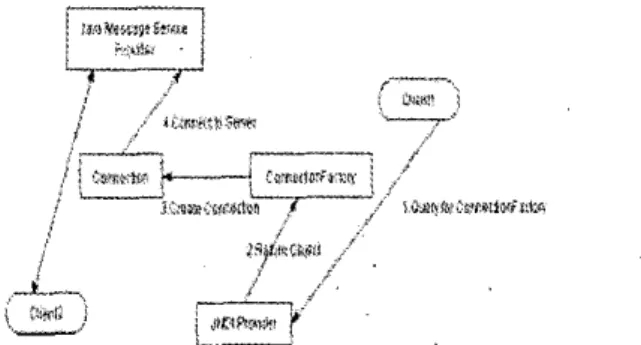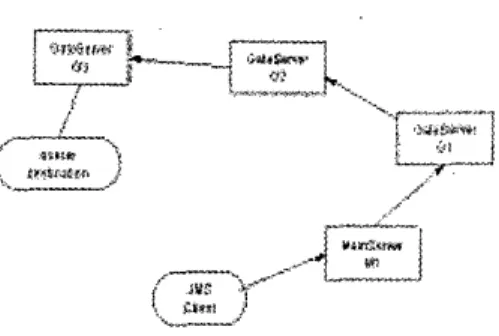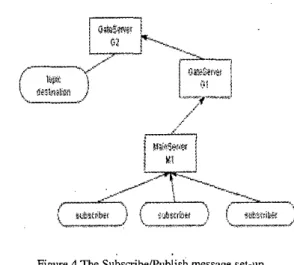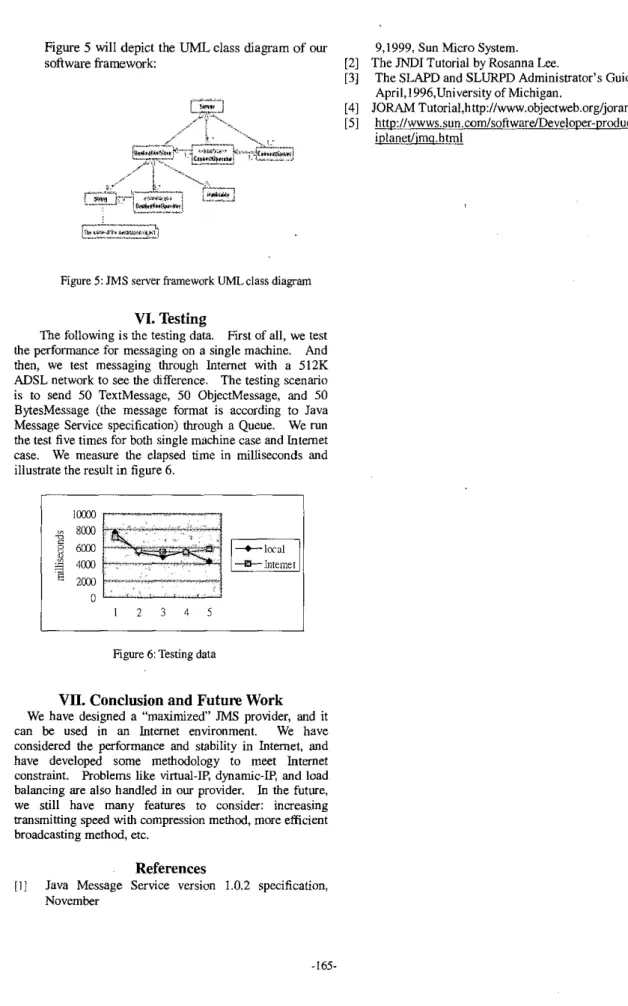A Software Framework for Java Message Service Based Internet
Messaging System
Hsiu-Hui Lee,
and
Chun-Hsiung TsengGraduate Jnstitute of Computer Science and Information Engineering National Taiwan University
Taipei, Taiwan
hhlee@csie.ntu.edu.tw,r900 14@csie.ntu.edu.tw Abstracr:Java Message Service is released by Sun
Microsystems as a standard way of message delivering and receiving. The purpose of this project is to implement a Java Message Service provider and provide a software framework to make some improvement on it. According to the specification of Java Message Service, Java Message Service is restricted in a pre-configured environment where each computer’s IP is h o w n in advanced and is completely connected. In this project, we design architecture to allow messaging in Internet. To integrate Java Message Service into Internet environment, there. are several issues to consider:
To resolve Java Message Service destination objects without physical IP.
An efficient and stable method for message routing is required.
Load balancing should be considered.
The capability to handle heavy messaging load on Internet should be ensured.
Keywords: Java Message Service, Internet, server design
I. Introduction
Java Message Service [ l ] is a set of interfaces released by Sun Microsystem as a hamework for enterprise messaging. There is currently some Java Message Service implementations
(JMS
providers) work fine in a simpleLAN
environment, such as “Java Message Queue” [41 and “Joram.” [SI Through Java Message Service, the message sender and message receiver can both hea client.
Also,they do not have to know exactly where each other is, the sender just sends messages to a “destination” and the receiver just receives messages from the same “destination.” There are two types of messages supported by Java Message Service: one is ‘point-tepoint” message and the other is “subscribelpublish” message. Before sending or receiving messages, the sender or receiver will first try to get a so called “COnnectiOnFactory” object, and get “Connection” object which represents real underlying connections from “ConnectionFactory” shown in figure 1. Senders and receivers will find the “ConnectionFactory” object with a pre-configured name, which is suggested to be similar with the “destination” name by the specification. However, according to the specification of Java Message Service, senders and receivers should either connect to the same Java Message Service provider or at least connect to providers having pre-configured direct connections with 0-7803-7840-7/03/$17.00 02003 IEEE
each other. This will be a big restriction when senders and receivers are put into an Internet. Still another problem is, senders and receivers should find their destinations through Java Naming and Directory Interface (JNDI) [4-51, which will be also an obstacle when messaging across Internet. Since JNDI willnot only require a directly connected provider but also require a carefully chosen JNDI name to avoid misunderstanding and to help senders and receivers to find the correct objects.
Figure 1 Traditional Java Message Service worktlow
Il.
Design Goals
In this project, we try to refine the Java Message Service specification to he suitable in the Internet environment. We define “Internet environment” as a network environment, which may across a huge amount of WANs and LANs. In Internet environment, machines may have floating I P and connections between machines may be
unstable. Therefore, to apply Java Message Service directly in such environment is impossible. We have the
following design goals to achieve; design a method for resolving destination objects with floating IP, design a method for message routing in Internet, achieve load-balancing in Internet and modify the Java Message Service data structure to be applicable in a heavy messaging load environment..
1
Resolving Destination Objects with Floating IP
A carefully designed look-up method is required if we
want to use Java Message Service in Internet. Since the destination could be at any place and even with no physical IP address, only through JNDI to search the destination is not sufficient. In this project, we will design a remote look-up method can look up destinations in anywhere of the Internet. And this method should also take care of the traffic load. We don’t want this cross-machine remote
lookup too expensive.
2
Remote Message
RoutingMethod
We should design a method for remote message routing. Generally speaking, current JMS implementations require their message senderslreceivers on directly connected machines, because we can only search for “destination” and “ConnectionFactory” objects in a LAN environment, which is unpractical when applying JMS to Internet. To riquire direct connections in that environment is quite reasonable, since it can benefit from the stability and speed of LAN environment. Traditional JMS implementations thus generally send and receive messages through direct connection. If w e apply Java M e s s a g e S e r v i c e architecture in Internet, we have to consider message forwarding and routing, because direct connection between every machine in Internet is not reasonable. Further more, since Internet connection i s far unstable than LAN
connection, the method we designed here should take both r o u t i n g s p e e d a n d s t a b i l i t y i n t o c o n s i d e r a t i o n .
3 Load Balancing in Internet
The deploying system for JMS destination should have distribution ability. When considering messaging in Internet, too many JMS destinations on the same provider will make this Internet node a severe bottleneck. Also, if
we store messages on this machine for future routing, this will drain this machine’s resource. This problem is not addressed in traditional JMS implementations, since “point-to-point” messages in a LAN environment is quite efficient especially with direct connections; although “subscriWpublisb” messages may require some queuing and buffering, the reliability of such network environment should greatly ease the problem. Internet environment is not as stable, so the message forwarding method will require enough buffering, this will make the problem even worse. Thus, allow users to configure and deploy their
J M S
destinations in distributed manner is in demand, otherwise the JMS implementation in Internet environment will be crippled.4 Handle Heavy Messaging Load
When considering Internet environment, we may have lots of
JMS destinations, which are participating in
messaging process. Traditional JMS providers basically use memory alone as their storage. Although they may store their destination objects in corresponding JNDI server, the messages associated with those destination objects are directly put in memory and the real implementation of JNDI server may vary. The above situation works fine since they only work in a LAN environment where messages canbe delivered as s m n as possible and there are not too many
destination objects. However, if we want to enhance Java Message Service to an Internet-level messaging system, we should consider more about the heavy load. In OUT project, we will provide a software framework that is more suitable
in
the Internet environment for JMS providers.-
In.
Architecture
In order to Java Message Service, a server adhering to the
specification is required. Traditional Java Message Service specification requires only a single server as the messaging broker. However, the architecture will not work in Internet environment. For our design, there are three kinds of
servers required for applying Java Message Service in an Internet environment. They are described below separately, and figure 2 is to depict the whole system architecture and the relationship of these servers. Furthermore, in order to make our messaging system applicable in Internet and keep the flexibility, we will introduce a software framework to design each server in the 5Ib section.
1
MainServer
Senders and receivers
(JMS
clients) should have direct connection to a local provider. However, we should extend the ability of traditional providers to work in Internet. We called this kind of provider a “MainServer.” While sending or receiving messages, requests are f i s t sent to MainServer, it will try to find the destination locally. ,If not found, MainServer will forward the request to its u p p e r - l e v e l - s e r v e r , w h i c h a c t s as a g a t e w a y .2 Gateserver
On one hand, a GateServer is a storage for the destinations shared by multiple MainServers,on the other, GateServer is also act
as a router for routing requests and messages. More than o n e Mainservers can connect a Gateserver, and a Gateserver itself can connect to another Gateserver. Further more, in order to achieve load balancing, a GateServer can have several attachable-mini-GateServers, which will be named as “MiniGateServers.” When requests from MainSrrvers arrive, the GateServei will r y to
locate the destination locally first, if not found, it will try to .find the destination at attached servers, if still in vain, it will forward this request to its connecting Gateserver.
3 MiniGateServer
The main purpose of MiniGateServer is for load
balancing. Since Internet is not a stable network environment, messages may not able to be properly sent at some time and we have to store messages before they are successfully transmitted. However, this will cause a lot of overhead, and requires many system resources. With MiniGateServer, we can easily configure it to take over some destinations originally deployed on a GateServer. This can reduce that Gateserver’s load. Another contribution of MiniGateServer is to enable destinations on servers in a dynamical or virtual IP environment be accessible. A MiniGateServer can dynamically attach to a Gateserver, thus, even if the IP of the MiniGaServer is changed, clients through the attached GateServer can still access it.
,.-L-..,
i *~MN i L-%--d Figure 2 Server ArchitctureIV. Message Flow
A messaging system should handle thousands of messaging efficiently and safely. According to the Java Message,Service specification, messages are classified into two catalogs: “Point-toPoint” messages or “Suhscribflublish” messages; we will describe how they are handled in our design below.
1 Point-to-Point
Message
In Java Message Service, a point-to-point message is called a “queue” message. This type of message will have exactly a sender and a receiver.
In a virtualldynamic IP environment, the target destination may be on a machine with no physical IP address. Thus, the target destination cannot be located in traditional JMS implementations. In our implementation, we use “MiniGateServer” to hold these destinations, and requests will be routed to these MiniGateServers through GateServers. Suppose we have a queue destination on GateServer G3, and our JMS client is connected to MainServer M1, which is connected to Gateserver GI. The Gateserver GI is connected to Gateserver G2 as its outlet that in t u n connext to GateServer G3. This set-up will be depicted in Figure 3. Now, suppose the N S client is sending or receiving the queue message from the queue destination. The request will first be forwarded to Mainserver M I , and M I will find the requested target is not a local destination, and then the request is forwarded to Gateserver GI. G I will check the destination again, and will still find the destination is not a local one. Then GI will create a routing packet, set the time-to-live information, and route tbe request to G2. After G2 received the packet, it will check the time-to-live information to make
sure
this packet is not out-dated. If the packet is still alive and the target destination is still not local to G2, G2 will continue routing the packet. If the packet is successfully routed toG3, the target destination will be found. If the original JMS client requests for sending message, then this message will be stored in G3, and if the
JMS
client requests for receiving messages, all messages for the target destinationwill be return to M1 to make future receiving more efficiently.
Er-+-
.,_+..^_._.‘..
.,..a
w n m r/---.~
.<J (,;E,
,j”
L-..---,Figure3 The Point-to-Point message set-up
2 Subscribehblish message
In Java Message Service, subscribdpublish messages are also called “topic” messages. Unlike queue message, which is “client request for receiving”, the
JMS
provider should automatically transmitting messages to subscriber clients without clients’ request.Traditional JMS implementations still have problems when the target destination does not have physical IP address, Furthermore, The nature of SubscriWPublish message will also make implementing Java Message Service in a virtualldynamic IP environment much more difficult, since the subscribers may come from every place with dynamic IP address. If we just record the subscribers’ current IP address and forward messages to all client machines, and check the client’s existence at the same time, this will produce incredible overhead. To overcome that problem, we design a “multi-level forwarding method.” We will describe this method below.
Suppose, tbe topic destination is at Gateserver G2, and a GateServer G1 connect to G2, and a Mainserver M1 connect to GI. Several subscribers connected to M1 subscribe to the topic destination. The set-up will be depicted in figure 4. When MI receives the request, it will register itself as a “proxy entry” in G1. G1 will first check if the topic destination is a local one and after GI assure the destination is a remote one, it will route the request to G2 and register GI itself as a ‘‘proxy entry” in G2. There may
be thousands of MainServers connected to G1 and they may
all subscribe to that topic destination. When G2 publish messages, it will publish to those :’proxy entries” instead of publishing to all subscribers. Of course, after messages arriving the MainServers, Mainservers should still forward messages to all subscribers. However, we assume Mainservers is as close to clients as possible, thus this “multi-level forwarding method” will decrease the numbers of packets which transmitting messages along a long Internet patb. Furthermore, our publishing thread will automatically schedule the publishing interval. Thus if we have only a few messages to publish, it will increase the publishing interval and try to collect as many messages as possible in a publishing session. This will also increase the performance.
1
Figure 4 The SubsrribdPubiish message set-up
V. Heavy Load Destination Storage
Up to now,.we have described the server architecture and the message flow of our messaging system. In our design, the server is able to handle messaging hierarchically, andwe have discussed load-halancing issues. However, for each server, we have assumed that all destination objects and messages are stored in memory until now. This may not be the case when we consider a real Internet world. In order to handle the heavy load elegantly, we may want to
store JMS destinations and their associating messages into different location, different disks, and even different database. And due to the unreliahility of Internet connection, transferring messages may fail, and we may
want to ensure messaging of some JMS destinations more strictly. That is, we want to have different mechanisms to manage different JMS destinations and their associating messages. Furthermore, uaditional JMS providers only support T C P connection, hut we may need different connection type for different group of JMS destinations, such as UDP, HTTP, and SSL ... etc. Below we will provide a software framework to achieve the goals.
1 JMS Server Framework
' 'Java Message Service is a standard established by Sun Microsystems a s a messaging framework. However, according to the specification, a Java Message Service server is a prerequisite for using Java Message Service. Of course, there are many commercial or non-commercial products now, but if we want to use'Java Message Service in a particular situation, for example, using it in an embedded system or using it to facilitate internal messaging between components in an application, we still need to
build our own Java Message Service server. In our project, we have several levels of servers working together to form a complete messaging system. To write a Java Message Service server is a quite tedious work, moreover, different servers may work on different host in different environment, optimization for each case is quite difficult. Thus, we have designed a flexible architecture for easier building p r o c e s s o f J a v a M e s s a g e S e r v i c e s e r v e r .
2
Architecture
paas: 1. Server
A Server is the control center of the whole framework. It
will contain several pairs of ConnectServers and Connectoperators and manage their lifecycle. A Server will
also maintain a DestinationStore as storage of Java Message Service destinations.
2. Connectserver and Connectoperator
For flexibility, our Java Message Service Server Frame work will not enforce a specific protocol for client
connection. Instead, we use
ConnectServerIConnectOperator pairs to fulfill connection work. A Connectserver may choose any proper protocol for client connection; for example, a Connectserver can be
designed as a HTTP server to interact with clients from
internet, and a ConnectServer can also act as a mail server to receive clients' request as e-mail. However, a ConnectServer should only handle connections, that is, it should not directly process request from clients. A ConnectServer will forward any client request to its corresponding Connectoperator, thus, a Connectoperator can be used by more than one Connectserver. Connectoperators will have reference to DestinationStore for Java Message Service operations.
3. DestinationStore and Destinationoperator
A DestinationStore is actually a hash table storing destinatiodDestination0perator pairs. In our design, Java Message Service destinations and its corresponding messages can be stored at any storage. Thus, we can use arrays, files, and even databases to store those messages. For flexibility, different storage can he accessed through different DestinationOperator, thus we can use storage with higher speed for destinations with high loading and use storage with grow-able size for destinations may have to
store huge amounts of messages in future.
4. Driverpool and Driver and DriverConnection
Clients for traditional Java Message Service Server typically rely on JNDI only to search their target destinations. However, since our frame can be applied on various environment even embedded systems, developers using our framework may want to use other methods for searching. We have wrapped searching-object methods as Driver; clients can get Driverconnection from DriverPool, and use Driverconnection as a standard interface to search objects. The underlying searching methods is hidden in Driver, thus provide both flexibility and convenience.
5.
System-independent JMS libraries6. System-dependent JMS libraries
We have separated our implementation of
JMS
libraries into two types: system-independent and system-dependent. This is because some JMS objects, like Message object, Destination object, are quite general, while others, like Connection object may be totally different according todifferent environment. By separating these two types of JMS libraries, we can have better re-usability in our implementation.
Figure 5 will depict the
UML
class diagram of our 9,1999, Sun Micro System.software framework [2] The JNDI Tutorial by Rosanna Lee.
The SLAPD and SLURPD Administrator's Guide,30 April, 1996,University of Michigan.
[3]
[4] JORAM Tutorial,bttp://www.objectweb.org/joram [5] htto://wwws.sun.mm/softwardDevelooer-orcducts/
iplanet/ima. btml
Figure 5 : JMS server framework UMLclass diagram
VI. Testing
The following i s the testing data. First of all, we test the performance for messaging on
a
single machine. And then, we test messaging through Internet with a 512K ADSL network to see the dfference. The testing scenario is to send 50 TextMessage, 50 ObjectMessage, and 50 BytesMessage (the message format is according to Java Message Service specification) through a Queue. We run the test five times for both single machine case and Internet case. We measure the elapsed time in milliseconds and illustrate the result in figure 6.1 2 3 4 5
I
Figure 6: Testing data
VII. Conclusion and Future Work
We have designed a "maximized'' JMS provider, and itcan be used in an Internet environment. We have considered the performance and stability in Internet, and have developed some methodology to meet Internet constraint. Problems like virtud-IP, dynamic-IP, and load balancing are also handled in our provider. In the future, we still have many features to consider: increasing transmitting speed with compression method, more efficient broadcasting method, etc.
References
[ I ] Java Message Service version 1.0.2 specification, November



